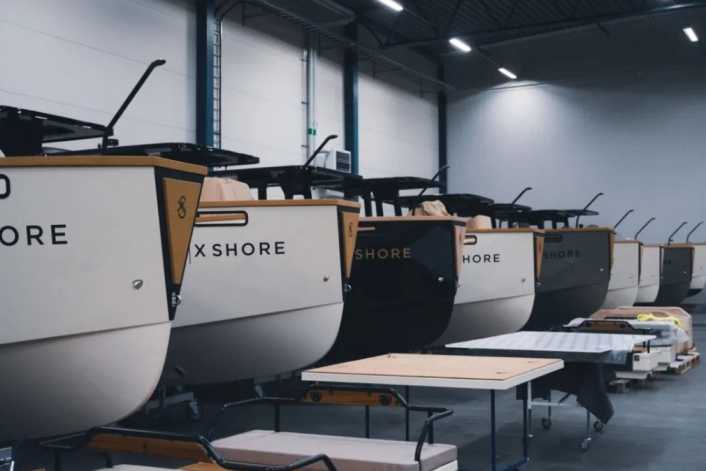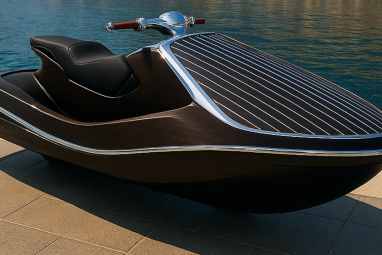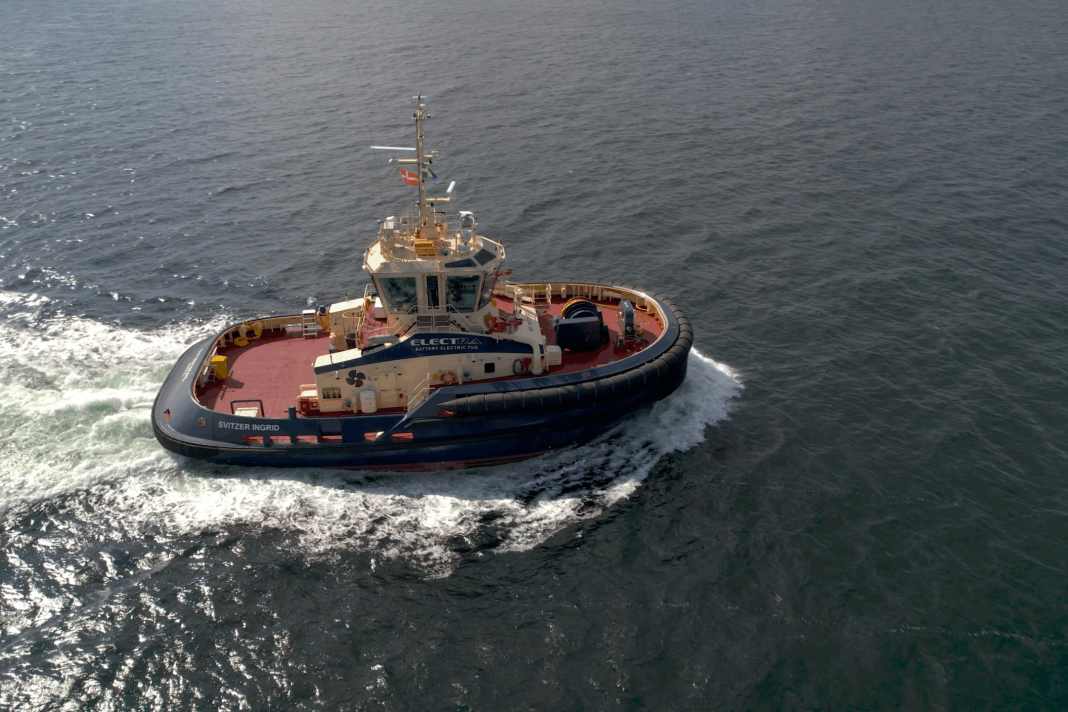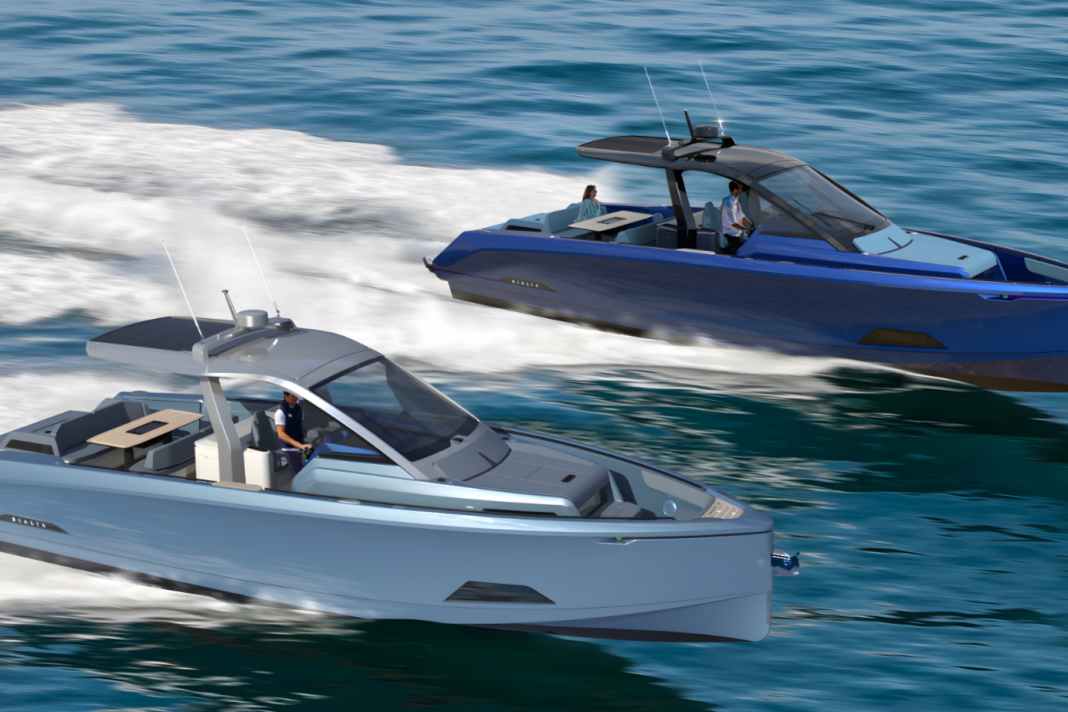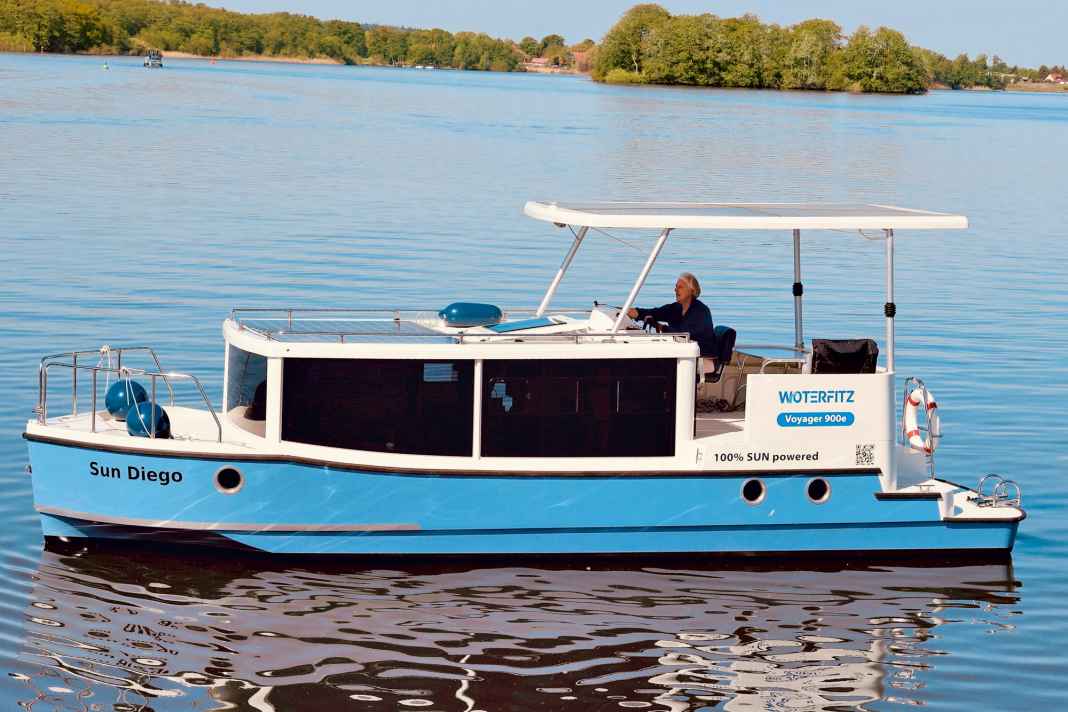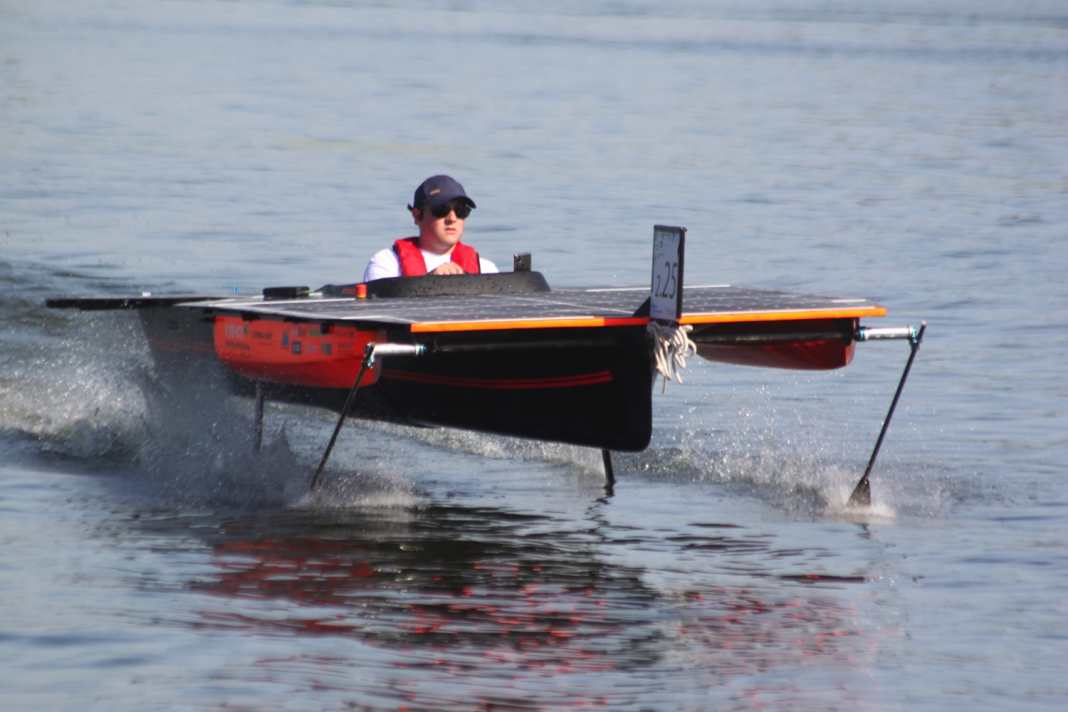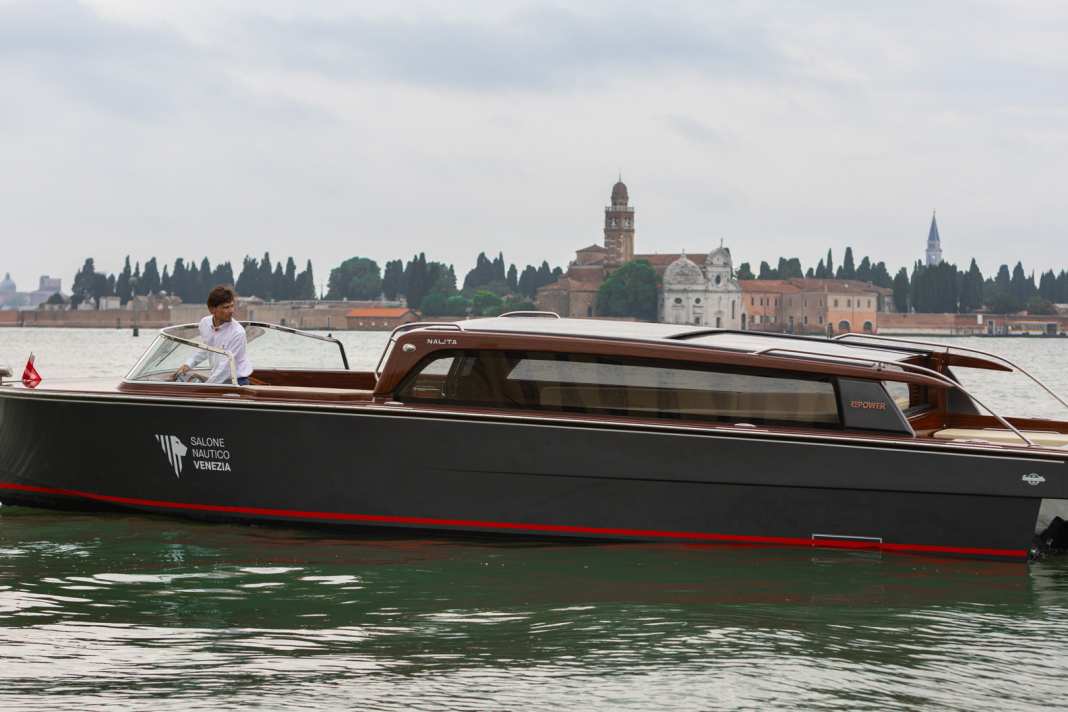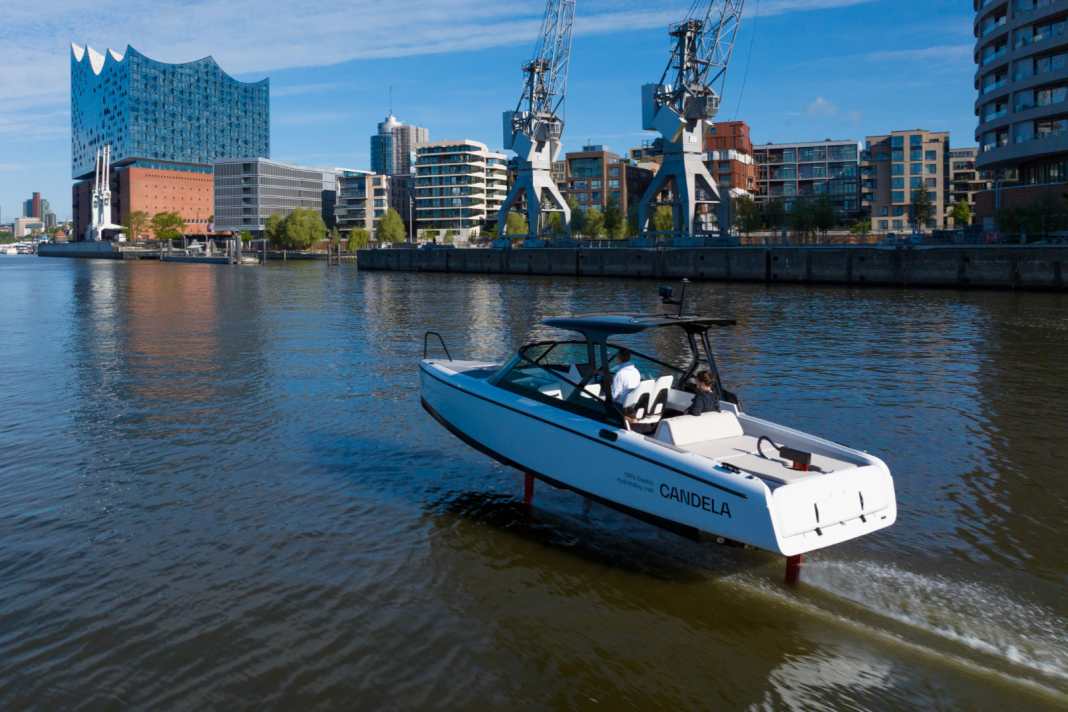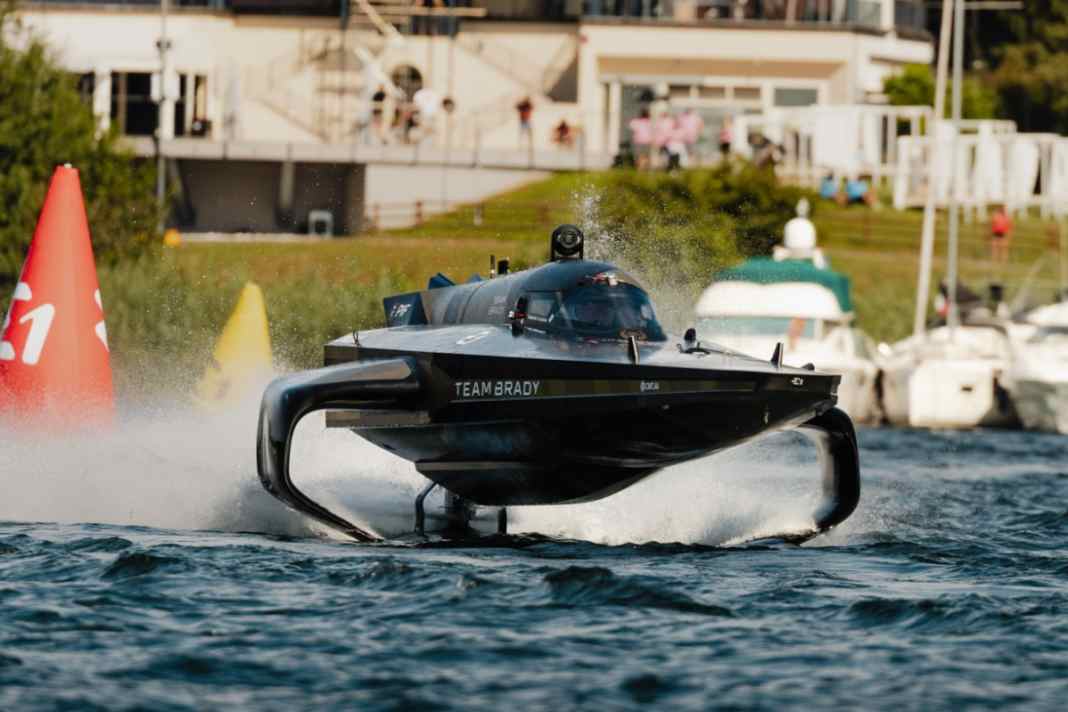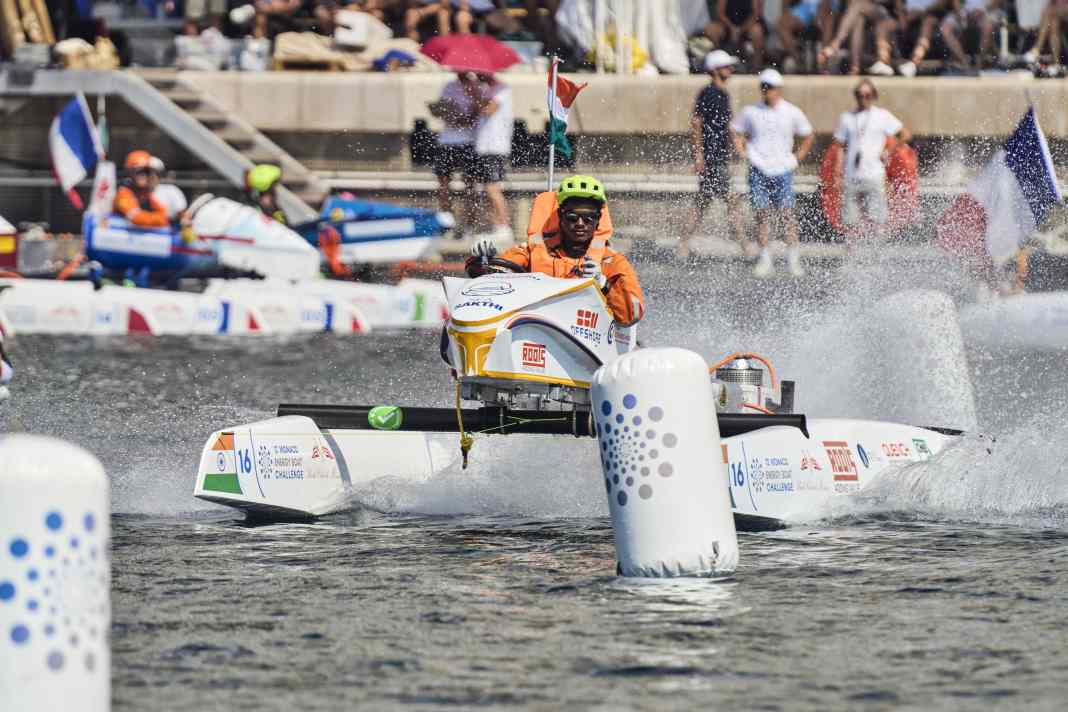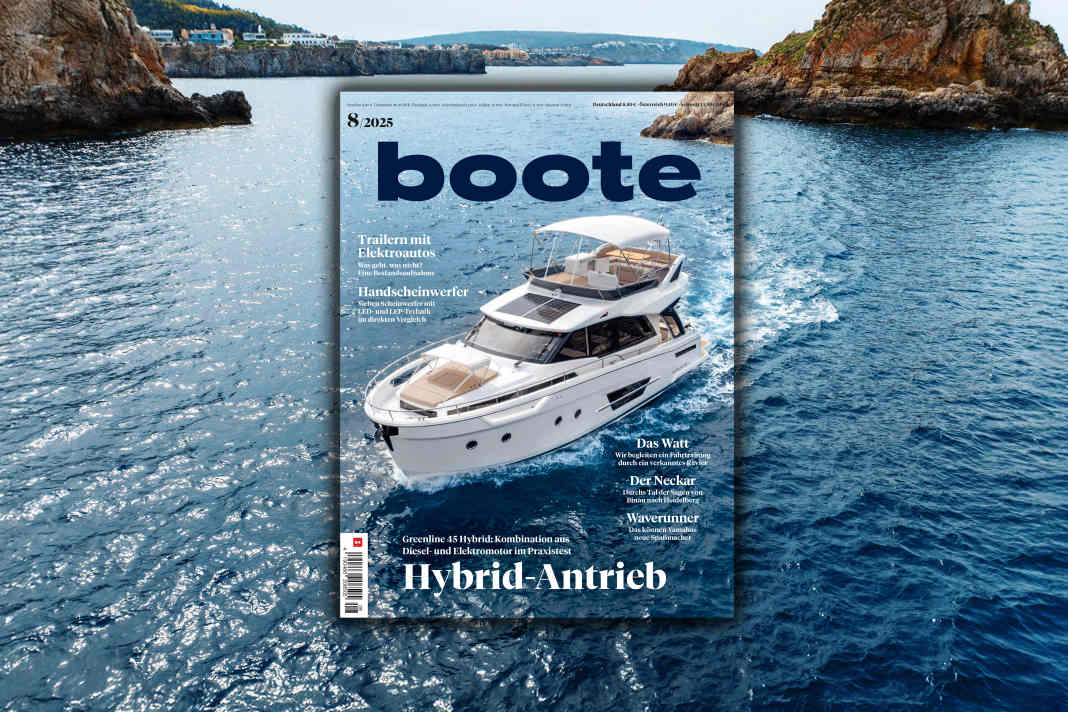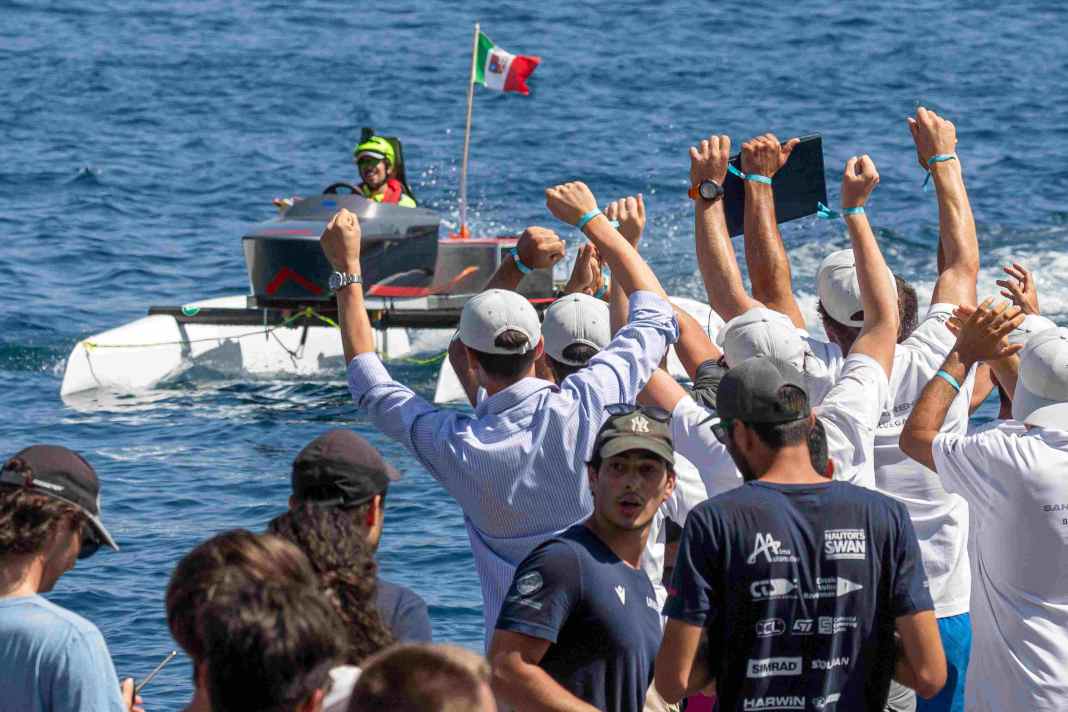Electric boats: The new fun is quiet and clean
It is not just on the roads that we are seeing more and more vehicles with electric drives, but also on the water: electric boats are no longer a rarity and e-mobility is also a big topic in the motorboat industry - among users and manufacturers alike. Opinions on the silent type of propulsion vary widely. For some, the rapid development of electric drive types is politically driven and not based on their actual advantages. For others, electric motors are the drive type of the future and there is no alternative.
BOOTE explains the real advantages of electric boats and where they are rightly criticised. One thing is certain: it remains exciting. Nowhere are technical innovations happening as fast as in the field of electromobility. In addition to the impressive electric boat models that are already on the market, we can expect a lot more in the coming years. With BOOTE, you are guaranteed not to miss any of it.
What is an electric boat?
Motorboats can be equipped with combustion engines or electric motors. The only difference between an electric boat and other boats is its drive system.
In combustion engines, the ignition of diesel or petrol in highly compressed air in the cylinder chamber triggers an explosion that ultimately drives a piston downwards. The vertical movement of the piston is converted into a rotary movement using a connecting rod and shaft - voilà, the propeller drive is complete.
The shaft and propeller are common to both electric and combustion engines. However, the electric boat has batteries instead of fuel tanks. And the motor itself also works according to a completely different principle: the so-called rotor is surrounded by a coil. If current flows through this, a magnetic field is created. In interaction with the magnetic stator surrounding the rotor, a rotary movement of the rotor is created. This allows the propeller shaft to be driven.
Compared to the combustion engine, the electric motor is significantly more efficient. High speeds can be achieved from the very first moment, which ensures significantly better acceleration at the start.
Pros and cons: What's in favour of electric boats, what's against?
So much for pure technology. But what are the advantages and disadvantages of this technology compared to the combustion engine? Are electric motors really the better, cleaner solution?
Clearly in favour of electric boats:
- Electric motorboats have a significantly better carbon footprint than combustion engine boats - if they are powered by green electricity (or by self-generated solar or wind power), their operation is even completely climate-neutral.
- Electric boats produce no harmful or smelly exhaust fumes and no oil is needed to lubricate the rubbing parts in the engine. This is not only good for the crew's health and sense of smell, but also for the environment. It is neither polluted by exhaust fumes nor can fuels or oils get into the water.
- Electric motors are cheaper to run than combustion engines: electricity is a much cheaper source of energy than fossil fuels such as diesel or petrol - not to mention the fact that these are becoming increasingly scarce.
- However, this is not the only reason why the running costs for operating an electric boat are lower than those for a conventional motorboat: electric motors are almost maintenance-free. Here too, users save costs - and time.
- Another big plus point is the noise level of electric boats: They run almost silently. Even adamant advocates of combustion engines cannot deny this advantage - and will get used to the silence.
- As mentioned above, electric motors are much more efficient as they do not require an idling speed. In practice, this means a high torque from the very first revolution and therefore better starting acceleration. Electric boats are therefore no fun brakes.
- While combustion engines sometimes have to be started with muscle power using a cable pull, electric motors can be started at the touch of a button.
- The speed and direction of electric boats can also often be regulated steplessly and without gear shifting. This makes them easier to operate overall.
- The simple change from one direction of rotation to the other and the infinitely variable control also ensure very good manoeuvrability.
- Electric boats are often equipped with additional electronic monitoring and navigation aids such as a display of the remaining range or power consumption, GPS or autopilot as standard.
- Even if the time-consuming charging of the batteries is one of the shortcomings of electric boats overall, you at least have to give them credit for the fact that you can charge them where you park anyway - namely at the mooring, without stopping at the petrol station.
- At the same time, you always have power on board thanks to the batteries - not only for running the engine, but also for all other devices. It is therefore no longer necessary to convert kinetic energy into electricity, as is the case on boats with combustion engines using an alternator.
- Another advantage is that e-skippers are guaranteed not to have to worry about driving bans. With the emission-free electric motor, you can fulfil any emissions standard.
The main disadvantages of electric boats are
- Nearly all of the cons against electric boats revolve around the batteries, which are required as power storage sources for the electric motors. The most frequently cited counter-argument of the limited range is also due to the batteries. Their energy storage capacities cannot yet keep up with those of fuel tanks and electric boats are therefore not suitable for some applications - for example, when travelling in strong currents or swell or when long distances have to be covered. However, you should bear in mind that your own driving style has a major influence on the range. Just as with combustion engines, consumption increases disproportionately above a certain speed.
- Another negative point is the purchase price of electric boats - and this is also due to the batteries. This is because they make up a significant proportion of the total price of electric boats. The higher the power range of electric motors, the larger the batteries need to be and the more expensive they are as a result. However, the higher purchase price can usually be recouped - through lower energy costs. Of course, this only happens if you drive enough.
- The charging time of the batteries is also a disadvantage: While the fuel tanks of a "normal" motorboat can be refuelled within minutes, the electric boat usually has to pause for several hours until its energy stores are fully recharged. You should therefore plan your routes so that charging can take place overnight.
- Critics also often criticise the battery manufacturing process, which requires raw materials such as lithium. These are sometimes mined in Africa and South America with a high level of environmental pollution and disregard for human rights. CO2 is also emitted during their transport to Europe. What is wrong, however, is that all of this jeopardises the positive overall balance of electric boats.
- The weight of the batteries can also be a problem: The cheaper lead-acid and AGM batteries in particular are very heavy. Even if the electric boat motor itself is considerably lighter than a combustion engine, the drive system as a whole is heavier due to the weight of the batteries.
- Although the system of an electric drive is very low-maintenance, the installation and commissioning of the battery bank, motor, propeller and power lines as well as any other components such as charger/inverter, motor controller, generator, solar or wind system and control devices on the control stand should be carried out by professionals and ideally by the same company. If system components do not fit together or are installed incorrectly, this can lead to premature wear, defects and safety deficiencies. If repairs do need to be carried out on the long-lasting components, the same applies here: It is better to call in a specialist than to do it yourself.
- Last but not least, it must be said that electric motors can only be considered up to a certain power requirement. Larger ships or boats that have to contend with stronger currents still need combustion engines or a hybrid propulsion system in order to be propelled over a longer period of time. Although electric motors now provide the necessary power for the popular planing motion, combustion engines are still the preferred means of choice for larger yachts when the bow needs to lift out of the water at high speed.
Electric - always a good alternative?
Conclusion: In most cases, electric boats are a good alternative to motorboats with combustion engines. The advantages of an electric drive should not only be considered when buying a new boat, but also if you already own one. Converting from diesel or petrol to electric is possible without any problems in most cases - regardless of whether you have an inboard, outboard, sterndrive or other type of drive. The batteries then take the place of the fuel tanks (or elsewhere - batteries can be positioned flexibly).
The market for used electric boats is also slowly expanding and you can also look for the right model there. However, you should be aware that the age of the batteries is limited and it may soon be time to invest in new batteries.
Boat type, engine, battery and intended use: What fits together?
If you want to buy an electric boat, just like buyers of combustion engine boats, you need to make sure that the watercraft is suitable for the intended use. This is because electric boats, like all other boats, come in a wide variety of designs. Yachts, catamarans, trimarans, sports boats, day cruisers, cabin cruisers, runabouts, inflatable boats, RIBs, gliders, displacement boats, semi-gliders, retro boats and classics - all of these boat types can be equipped with electric or hybrid drives. The waters on which you want to travel should also play a role in the choice of boat and its motorisation.
Just as the electric boat must fit the needs of the user, the drive system must also fit the boat. The drive system in turn consists of several components that must fit together. The electric motor, batteries, propeller, power cables and charger must fit together.
To make the right choice here, you need some expertise or good advice. The required motor power is roughly calculated from the length and weight of the boat. Depending on how long you want to travel with the boat, you then calculate the required battery capacity from the engine power. Of course, the external conditions, which are rarely the same on the water, also play a role. If in doubt, it is better to take the larger battery so that you are not suddenly unable to manoeuvre in a little more wind and waves.
The range of electric boats can be extended, for example, by using solar or wind energy or by adding a generator. There are also purely solar-powered boats whose batteries are charged exclusively with solar energy - and sometimes even feed surplus electricity into the harbour. The fact that sailing boats are powered by wind energy is nothing new. However, wind can also be used to operate wind generators, which in turn charge the batteries of electric motors.
Know-how about batteries: Which types are suitable and how do you handle them?
There are various types of batteries that are suitable for electric boats. Lithium batteries are the highest quality and lightest. However, they are also the most expensive. Not every user will find it worthwhile to dig deeper into their wallet. AGM batteries are a solid, slightly cheaper alternative for skippers who do not use their watercraft that often. You should definitely steer clear of cheap solutions such as car starter batteries - they are not suitable for operating electric motors. Lead-acid/wet batteries are also no longer state of the art and should only be used if there are no high expectations in terms of quality - and savings have to be made at all costs. GEL batteries are more suitable for lighting, a cool box or similar, but less so for operating the electric motor. Conclusion: If you save on the batteries, you will lose out later.
But even high-quality lithium-ion batteries do not last very long if they are not treated with care. The following rules should be observed to ensure that they achieve their maximum service life and actually deliver the promised charging cycles:
- Boat batteries must never be run completely empty: Depending on the type of battery, there must always be 20 to 35% residual charge - deep discharge is fatal for the batteries.
- Batteries should not be exposed to extreme temperatures - both extreme heat and cold will damage them.
- Fast charging can also shorten the service life of batteries.
- The batteries should be recharged immediately after every journey - the longer they are left empty, the worse.
- The charger must be suitable for the batteries.
If handled properly, a high-quality lithium battery can last for ten years. However, this is the exception rather than the rule and the average age of rechargeable batteries is significantly less.
The field of energy storage and charging technology is constantly evolving. It is therefore to be expected that some problems relating to batteries will be solved in the next few years, making electric boats even more attractive.
Electronics on electric boats: Smart and convenient basic equipment
As electric boats tend to be newer boats, they usually have modern, convenient equipment. Especially when it comes to electronic devices and aids, they are often ahead of motorboats with combustion engines. After all, it requires little additional effort to display engine or battery data on a central display unit at the helm. GPS reception and navigation devices are also often part of the basic equipment on electric boats. Additional convenience is provided by the stepless gearstick, which electric boats are often equipped with. This makes electric boats very easy to operate and manoeuvre. This makes them the perfect boat for beginners.
Purpose of electric boats
While small boats with electric outboards used to be the main type of boat available, there are now also larger motorboats with electric propulsion. Cabins, sleeping cabins, galleys, wet rooms and leisure facilities on deck can now be found on electric yachts as well as on conventional motor yachts. So there is a suitable electric boat for almost every purpose.
Anglers in particular have been increasingly focussing on electric drives for some time now. When fishing, precise control of certain points is often necessary - this works particularly well with electric motors. Especially when they are attached to the bow - which is why there are electric bow motors specially developed for anglers. These often have additional functions such as remote or foot pedal control, autopilot or automatic speed control, which help anglers to be successful.
Houseboats, which have become a popular holiday home for families, are currently experiencing a boom. Many of these rectangular, rather sluggish watercraft are powered by electric motors and also have solar panels on their large roofs.
Not every electric boat is suitable for salt water. Some models are available in different versions for salt and fresh water.
Electric boats on inland waterways: Family and environmentally friendly
There are more and more inland waterways where petrol or diesel engines are not permitted due to their emissions. Electric boats are then the only option if you want to take to the water motorised. The problem of swell, which sometimes causes problems for electric motors, is then also eliminated. Many models are therefore designed for inland waters from the outset. Conversely, the infrastructure along inland waterways is often perfectly developed for electric boats - especially in places where only electric boats are permitted. Take the Steinhuder Meer, for example. If you don't have your own electric boat, you can hire an electric boat from Kielhorn boat hire - without the need for a sports boat licence. The boat hire company's small boats only have a very low motorisation and are therefore suitable for beginners and families. Because e-boats are so user-friendly, there have long been boat hire companies specialising in electric boats on many other lakes, such as Lake Chiemsee, Lake Starnberg, Lake Eibsee and Lake Wannsee in Berlin.
Strict exhaust emission standards also apply on Germany's largest lake, Lake Constance. Internal combustion engines may still be used there, but only if they do not exceed the BSO Stage 2 limits. Many owners are therefore opting for electric motors, which means that the necessary infrastructure for electromobility on the water is also available around Lake Constance.
As a general rule, electric boats are also permitted wherever motorised boats are permitted. Speed limits also apply equally to all leisure boats. Apart from the exceptions already mentioned on many lakes, there are also other cases in which electric boats have advantages. In some regions, for example, e-boats with a maximum power of one kilowatt are still permitted on all non-navigable waters.
Safety on e-boats
The simple operation of electric boats should not lead to carelessness. A recreational boating licence is required to operate electric boats with a power output of 7.5 kilowatts or more, and skippers should have the necessary knowledge of the area, traffic regulations, technical equipment, safety equipment, etc. before setting off.
In complete contrast to the lakes as inland watersthe lake - or even theHighlake. Electric boats are not yet suitable for this. Neither can enough batteries be stored on board to provide enough energy for an ocean crossing, nor can electric motors cope with very high waves and storms.
But even on still waters, even more so than with combustion engines, it is important to drive efficiently if you don't want to end up with an empty battery after a short time.
Manufacturers and brands: Who is ahead in the race for range and efficiency?
Boat manufacturers are doing the same as car manufacturers (albeit with a slight delay) and are upgrading their e-drives. Those who don't keep up will be left behind in the long term. And so the vast majority of shipyards also offer at least some of their models with electric motors. Many of the motors fitted to these boats come from Torqueedo, the world's leading manufacturer of electric boat motors.
However, there are also shipyards that specialise in the construction of e-boats. For example, Greenline, Frauscher, Alfastreet Marine, My-Electroboat, Say-Carbon, Lex-Boats or Marian. In the area of double-shell small boats and RIBs, Whaly offers simple, affordable solutions made of polyethylene.
Are you ready for the future?
Conclusion: there is happiness on the water without the smell and noise of diesel engines. Driving pleasure and environmental friendliness no longer have to contradict each other.
E-mobility is hotly debated and divides skippers. Find out for yourself what your needs are - and whether an electric boat can fulfil them. Chartering an e-boat first and familiarising yourself with the technology and all its advantages and disadvantages in this way is certainly a good idea. The informative BOOTE articles can also help you make the right decision.
